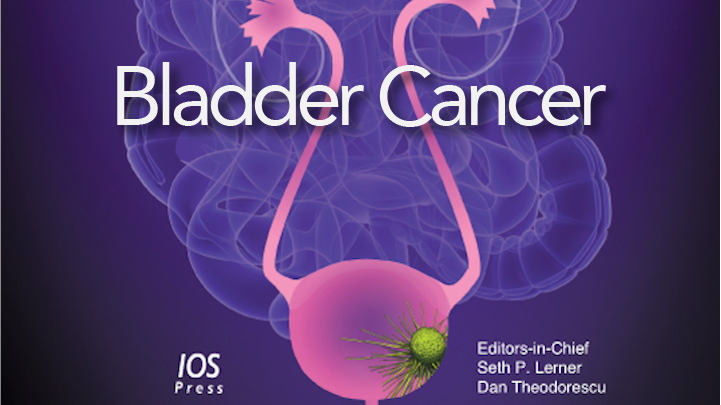
Bladder Cancer Journal Vol. 5 Issue 4
Modeling Tumor Heterogeneity in Bladder Cancer: The Current State of the Field and Future Needs
BACKGROUND: Tumor heterogeneity has been recognized in many cancer types for decades. However, the significance of tumor heterogeneity on disease course and clinical outcome in bladder cancer is of more recent interest to researchers and clinicians. This is especially true as morphologic and molecular heterogeneity has the potential to confound accurate diagnosis, efficient prognostication, and subsequent clinical management. While this is true, it is not always clear what laboratory models are available or suitable for the study of these important clinical phenomena. OBJECTIVE: To review in vitro and in vivo laboratory models for the study of morphologic and molecular tumor heterogeneity in bladder cancer. METHODS: We undertook a review of PubMed with a focus on identifying suitable models for the study of tumor heterogeneity in bladder cancer. RESULTS: We provide a review of common in vivo (genetically engineered mice and patient-derived xenografts) and in vitro (established cell lines and organoid systems) models and discuss their utility in the study of morphologic and molecular tumor heterogeneity in bladder cancer. CONCLUSION: Genetically engineered mouse models and patient-derived xenografts provide complementary approaches for the study of tumor heterogeneity in bladder cancer. In addition, cell culture-based systems provide a system amenable to genetic manipulation and mechanistic studies, while organoid systems bridge the gap between in vivo and in vitro systems. However, the availability of models to study molecular heterogeneity is limited, partly because of a relative lack of molecular characterization of available models. In summary, while models for the study of specific subsets of morphologic heterogeneity are available, more models are required for studies of molecular heterogeneity. This shortcoming could be partially addressed by more comprehensively characterizing currently available model systems. In addition, each system/approach has advantages and disadvantages, and care should be taken when selecting a given model.
Non-Coding Mutations in Urothelial Bladder Cancer: Biological and Clinical Relevance and Potential Utility as Biomarkers
BACKGROUND & OBJECTIVE: Whole genome sequencing has identified recurrent non-coding mutations that may be important in carcinogenesis. We investigate the frequency of 5 such non-coding mutation hotspots in urothelial bladder cancers (UBCs) and assess their potential for UBC detection and prognostication. METHODS: DNA extracted from 302 UBCs was subjected to targeted next generation sequencing of non-coding mutation hotspots in GPR126 , PLEKHS1 , TBC1D12 , LEPROTL1 and WDR74 . The frequency of mutations, and associations with stage, grade, age, gender, smoking status, clinical outcomes, mutation signatures and gene expression were analysed using χ 2 tests, logistic
Adverse Events During Neoadjuvant Chemotherapy for Muscle Invasive Bladder Cancer
PURPOSE: Neoadjuvant chemotherapy (NAC) improves survival in muscle invasive bladder cancer (MIBC). Rate of adverse events (AE) have been reported only in randomized clinical trials (RCT). Purpose was to evaluate incidence, type, and risk factors of AEs during NAC treatment in a population-based setting. MATERIAL AND METHODS: The Finnish national cystectomy database covering years 2008–2014 was utilized. NAC associated AEs were reported by Common Terminology Criteria for Adverse Events (CTCAE) v.5.0. AEs during NAC in five-tier severity scale was the outcome measure. Spearman correlation between AEs and 22 clinical variables were calculated. P -values were corrected for multiple
Cisplatin Ineligibility for Patients With Metastatic Urothelial Carcinoma: A Survey of Clinical Practice Perspectives Among US Oncologists
BACKGROUND: Cisplatin-based chemotherapy is the first-line (1L) treatment for eligible patients with locally advanced/metastatic urothelial carcinoma (mUC). However, many patients with mUC are ineligible for cisplatin-based therapy due to age- or disease-related factors. Specific criteria used by practicing physicians to determine cisplatin ineligibility have not been well characterized. OBJECTIVE: To understand US oncologists’ perspectives and self-reported treatment preferences related to cisplatin-ineligible patients with mUC. METHODS: An electronic survey was administered (November-December 2017) to a random sample from a panel of US oncologists who had agreed to participate in periodic surveys. Eligible participants were required to have
BACKGROUND: Despite established guidelines for bladder cancer (BC) management, significant treatment variability remains across the United States. OBJECTIVE: To report the impact of a tertiary center, bladder cancer multidisciplinary clinic (BCMC) on diagnostic evaluation and treatment recommendations in externally referred patients with BC. METHODS: Our BCMC clinic format includes simultaneous consultation with urologic, medical and radiation oncology, with real-time expert genitourinary pathology and radiology review. We retrospectively assessed all external referrals for concordance between outside radiology/pathology records and BCMC interpretation after central review and explored potential differences between outside treatment plan and BCMC recommendations.

